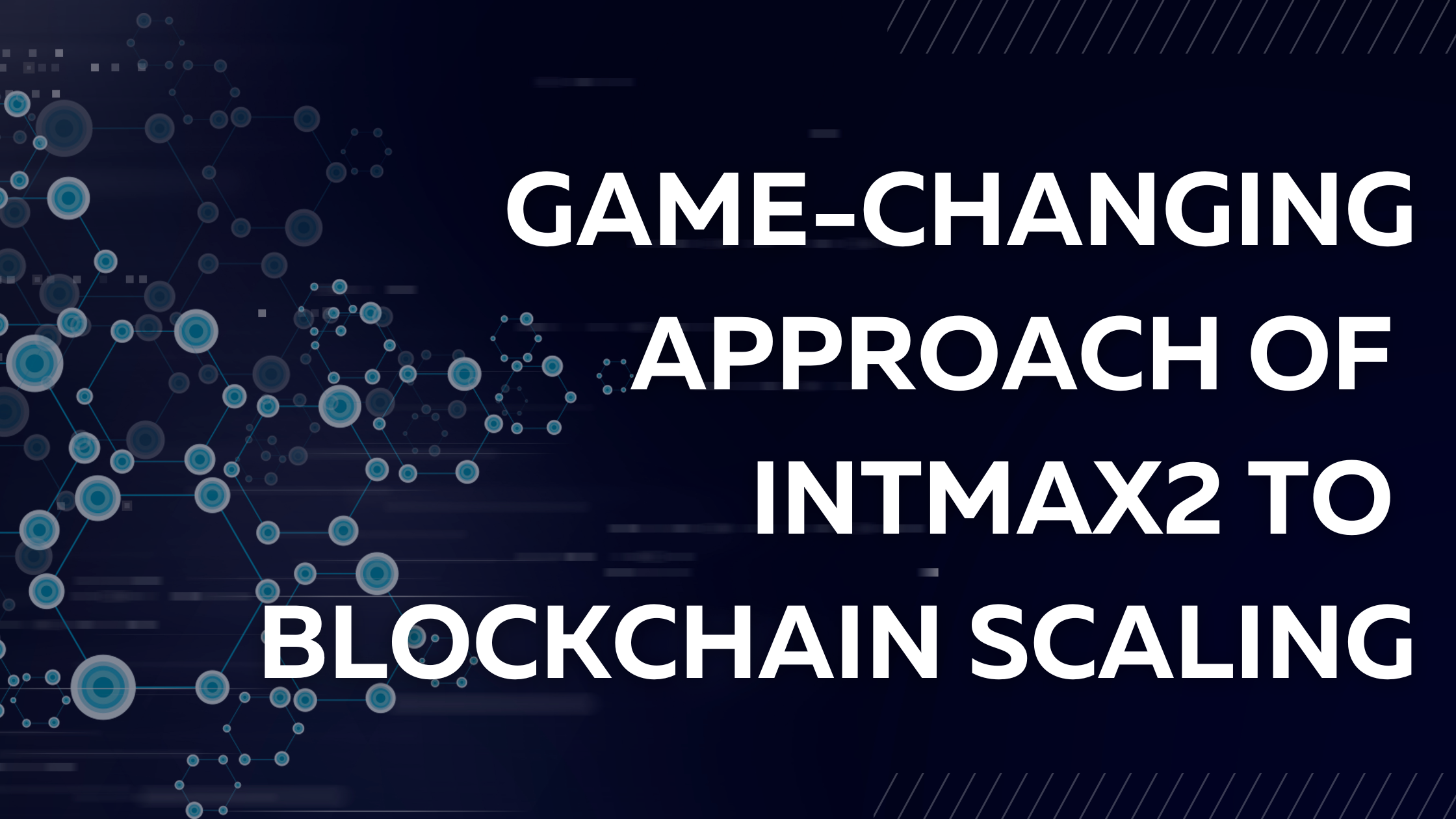Understanding the Game-Changing Approach of Intmax2 to Blockchain Scaling
 Glory Praise Emmanuel
Glory Praise Emmanuel
Blockchain technology has revolutionized various industries by providing a decentralized, secure, and transparent way to handle transactions and data. However, as the technology evolved, developers faced significant challenges when building on Layer 1 (L1) blockchains. The emergence of Layer 2 (L2) solutions aimed to address these issues but introduced new complexities. This article explores the problems associated with L1 and L2 blockchains, how Intmax2 offers innovative solutions, and why developers should consider building on this protocol.
Challenges of Building on L1 Blockchains
L1 blockchains, such as Ethereum, serve as the foundational layer of blockchain technology. Despite their groundbreaking potential, developers encounter several hurdles when building directly on these platforms:
Scalability: L1 blockchains often struggle with scalability, as their capacity to process transactions is limited. For instance, Bitcoin can handle approximately 7 transactions per second (TPS), while Ethereum manages around 30 TPS. This limitation results in network congestion and high transaction fees during peak usage times.
Transaction Speed: The low TPS rate leads to slower transaction confirmations, making L1 blockchains unsuitable for applications requiring high throughput and fast processing times.
Cost: High transaction fees, driven by network congestion and limited scalability, deter users and developers from utilizing L1 blockchains for everyday transactions and applications.
More so, Vitalik Buterin, Ethereum's co-founder, introduced the blockchain trilemma, highlighting the challenge of balancing security, scalability, and decentralization. Think of it like juggling three balls: security ensures the system is safe from attacks, scalability allows it to handle more users and transactions, and decentralization prevents any single entity from taking control. Improving one aspect often makes it harder to maintain the other two, creating a constant balancing act for developers.
The Emergence of L2 Solutions
To overcome these issues, Layer 2 (L2) solutions were developed, which add extra layers to the main blockchain (Layer 1) without changing its core structure. Common L2 solutions include:
Rollups: Rollups aggregate multiple transactions into a single batch, which is then processed on the L1 blockchain. This approach reduces the load on the L1 network, improving scalability and lowering transaction fees.
Sidechains: Sidechains are independent blockchains that run parallel to the L1 blockchain. They facilitate faster transactions by offloading some of the computational work from the main chain.
State Channels: State channels allow users to conduct multiple transactions off-chain and only settle the final state on the L1 blockchain, significantly enhancing transaction speed and reducing costs.
These L2 solutions address many scalability issues and even help blockchains run faster and cheaper, but they come with challenges. Implementing and maintaining L2 solutions can be technically challenging, requiring developers to manage interactions between the L1 and L2 layers. Also, ensuring that off-chain transaction data remains available and verifiable can be problematic, especially in the case of rollups and state channels, etc.
Intmax2 addresses these complexities using advanced cryptographic techniques and a stateless architecture to streamline data handling and verification processes. This allows Intmax2 to maintain high performance and scalability without sacrificing security or decentralization, ensuring that transactions remain efficient and secure, even offline.
What is Intmax2?
Intmax2 is an innovative Zero-Knowledge rollup (ZK-rollup) protocol that addresses the limitations of Layer 1 (L1) and Layer 2 (L2) solutions through a stateless architecture, enhancing scalability, security, and decentralization. By maintaining cryptographic proofs instead of the entire blockchain state, Intmax2 significantly boosts scalability and ensures data privacy and security with advanced cryptographic techniques.
How Intmax2 Utilizes Statelessness
Statelessness, when applied to blockchain, means that networks operate without keeping exhaustive histories of all past transactions to validate new ones, significantly reducing the data burden on each node. This approach allows for faster processing and greater scalability, making blockchain systems leaner and more efficient, thereby addressing the scalability challenges faced by many current networks. Intmax2 leverages this concept to enhance scalability.
Intmax2 achieves statelessness by shifting data and computational costs to the client-side, with block producers only generating transaction commitments, distributing inclusion proofs, and aggregating signatures, enabling permissionless and highly scalable block production.
Also by maintaining cryptographic proofs instead of the entire blockchain state. For example, when a user executes a transaction only 5 bytes of data are needed to verify online transactions. This method drastically reduces the data burden on each node, allowing for faster processing and greater scalability.
How Intmax2 Works
Intmax2 optimizes the verification and posting of user transactions on-chain by employing the Boneh-Lynn-Shacham (BLS) signature scheme for signature aggregation. This scheme allows for multiple individual signatures to be combined into a single aggregated signature, ensuring the integrity of transactions with minimal on-chain data. This approach significantly reduces the data load on the blockchain, enhancing both transaction efficiency and scalability.
Intmax2 addresses security and privacy issues through its innovative design and cryptographic techniques. By hosting only 5 bytes of information on-chain, Intmax2 ensures that block producers do not receive transaction histories. This approach limits their role to producing blocks and trees without verifying transaction validity, allowing for a fully stateless and simple, censorship-resistant rollup.
The protocol leverages cyclic recursive zero-knowledge proofs (ZKPs) to validate the entire chain of transactions at a constant and minimal cost. This method ensures that by verifying the most recent ZKP, the entire chain of correctness back to the origin is validated, providing fast and efficient system verification.
Since it is implemented using cyclic recursive ZKPs, the validity of the network can be verified on the client side with O(1) complexity. Users can remain offline for a certain period and still synchronize upon reconnection. Therefore, security and privacy can be maintained without the need to stay continuously online.
In terms of scalability, Intmax2 uses significantly less on-chain data than any existing rollup, supporting up to 1,000 transaction batches per second on Ethereum. Each batch can transfer an unlimited number of tokens to unlimited recipients, potentially executing up to 64,000 transfers per second without additional data costs. The system’s ability to parallelize according to the number of users further enhances scalability.
Intmax2 promotes decentralization by requiring very low node resources, making the system fully decentralized. This design supports a healthy Layer 2 (L2) environment that prioritizes developer convenience alongside non-negotiable scalability and security, ensuring a robust and efficient blockchain protocol.
Usecases To Build On Intmax2
Intmax2 is a versatile blockchain protocol designed for applications needing fast, secure, and scalable transactional services with adjustable privacy. It is ideal for decentralized finance (DeFi) projects and supports cost-effective transactions crucial for financial markets and trading platforms.
Its efficient handling of transactions and data privacy features also make it perfect for non-fungible tokens (NFTs), gaming, and supply chain management, ensuring seamless transactions, traceability, and authenticity of products. Intmax2's high throughput and low latency capabilities also support real-time data processing, enabling innovative and efficient blockchain solutions across various industries.
Conclusion
Developers should build on Intmax2 because its stateless architecture ensures high transaction throughput and low latency, facilitating high-performance applications. The protocol employs advanced cryptographic techniques to provide robust security and privacy, safeguarding user data and transactions. Its design simplifies development by reducing traditional blockchain complexities, allowing developers to focus on innovation.
Additionally, Intmax2's adaptable and future-proof infrastructure ensures that applications can evolve with technological advancements, making it a smart choice for forward-thinking developers. With its upcoming testnet in August and mainnet launch in Q4 of 2024, Intmax2 offers developers a compelling opportunity to build the next generation of decentralized applications; sign up here to be among the first to join!
For more information about INTMAX, you can refer to the resources provided below:
Subscribe to my newsletter
Read articles from Glory Praise Emmanuel directly inside your inbox. Subscribe to the newsletter, and don't miss out.
Written by

Glory Praise Emmanuel
Glory Praise Emmanuel
Glory Praise Emmanuel is a Frontend Engineer, Technical writer and Blockchain Developer based in Nigeria. She is passionate about providing solutions with technology and making the world a better place. She is interested in Open Source and community building.